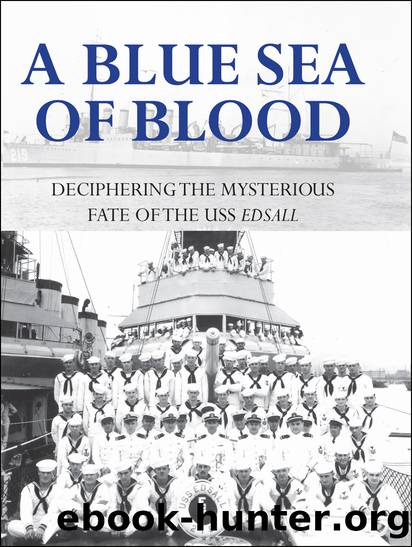A Blue Sea of Blood by Donald M. Kehn

Author:Donald M. Kehn
Language: eng
Format: epub
Publisher: MBI
Published: 2010-08-14T16:00:00+00:00
The track chart of the final engagement of USS Edsall (DD-219) against the Support Force of Kido Butai on the afternoon of March 1, 1942. Senshi Sosho Vol. 26, p. 497
Perhaps less than fifty miles away, floating in rising seas only slightly calmed by tons of heavy bunker oil, were several hundred survivors of Pecos. More than a few of these men heard and felt the gunfire and explosions from Edsall’s desperate last action as she led Kidō Butai’s Support Force battlewagons and cruisers northward, away from the helpless survivors of the oiler’s sinking and a fuming Vice Admiral Nagumo and his carriers.* At least two of the men treading water were U.S. Naval Reserve officers who had traveled to Manila before the war in the SS Harrison with, among others, Ensign John W. Gustin, Edsall’s communications officer. Afterward they, too, reported hearing “heavy gunfire from the direction the Edsall had taken . . . later in the day.”† At 8:52, they and other Pecos survivors, who by then had grown “very depressed,” were the recipients of one of the Pacific war’s great unsung acts of courage as the distinctive outline of a four-piper appeared in silhouette above the dark seas. It was the Whipple.
Having risked everything to re-enter the area, Whipple first sighted flares in the distance and then clusters of men in the water. One Langley survivor, Signalman 3rd Class Lowell Barty, recalled, “[We] were scattered out on the water as far as you could see. There was probably close to 800 men in there. You could see them as the waves would go up and down.” At 9:05 Whipple began hauling the exhausted, oil-covered, and traumatized survivors of Pecos from the black, pitching waves. Whipple took aboard some 220 men and would have rescued many more, but a submarine contact was made around 10:00. Already jittery from previous alerts, and the known proximity of Japanese carriers—which for some reason they imagined were at least one hundred to two hundred miles distant—Commander Crouch, in agreement with Commander Abernethy, decided to clear the area.
It is estimated that more than 450 men died in the sinking of Pecos, either killed in the bombing attacks or lost in the water. A number who perished were hard-luck survivors of Langley, Houston, and Stewart. Signalman Barty from Langley thought the number of casualties was even higher: “We had to get under way and leave about 600 men there in the water. And none of them was ever heard from again.” He had disobeyed orders from an infuriated naval officer in the balsa life raft that he and a dozen other men were clinging to by swimming with his friend Reginald Mills to the four-piper on the horizon. The two exhausted sailors just made it. Lowell Barty was dragging himself up a cargo net on the side of Whipple when a panic-stricken sailor climbed over him and knocked him back into the water. Too tired to regain the nets, he wrapped a chain around himself and two sailors on the destroyer hauled him up.
Download
This site does not store any files on its server. We only index and link to content provided by other sites. Please contact the content providers to delete copyright contents if any and email us, we'll remove relevant links or contents immediately.
| Africa | Americas |
| Arctic & Antarctica | Asia |
| Australia & Oceania | Europe |
| Middle East | Russia |
| United States | World |
| Ancient Civilizations | Military |
| Historical Study & Educational Resources |
Flight by Elephant(1509)
The Rise and Fall of the Third Reich: A History of Nazi Germany by William L. Shirer(1389)
Unbroken: A World War II Story of Survival, Resilience, and Redemption by Hillenbrand Laura(1125)
German submarine U-1105 'Black Panther' by Aaron Stephan Hamilton(1033)
Last Hope Island by Lynne Olson(942)
A Bridge Too Far by Cornelius Ryan(936)
War by Unknown(932)
The Victors - Eisenhower and His Boys The Men of World War II by Stephen E. Ambrose(907)
Rogue Heroes: The History of the SAS, Britain's Secret Special Forces Unit That Sabotaged the Nazis and Changed the Nature of War by Ben Macintyre(897)
The Guns at Last Light: The War in Western Europe, 1944-1945 by Rick Atkinson(895)
0060740124.(F4) by Robert W. Walker(877)
The Hitler Options: Alternate Decisions of World War II by Kenneth Macksey(875)
The Railway Man by Eric Lomax(854)
All the Gallant Men by Donald Stratton(824)
Hitler's Vikings by Jonathan Trigg(819)
The Battle of Berlin 1945 by Tony Le Tissier(812)
A Tragedy of Democracy by Greg Robinson(811)
Churchill's Secret War by Madhusree Mukerjee(809)
Hitler's Armies by Chris McNab(791)
